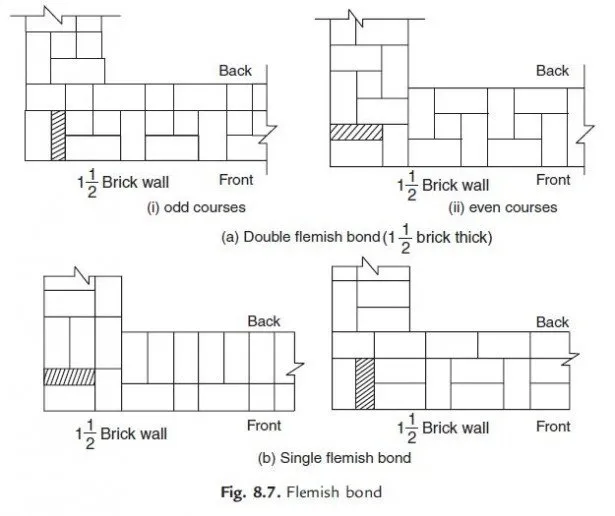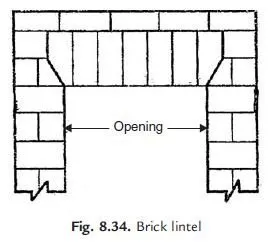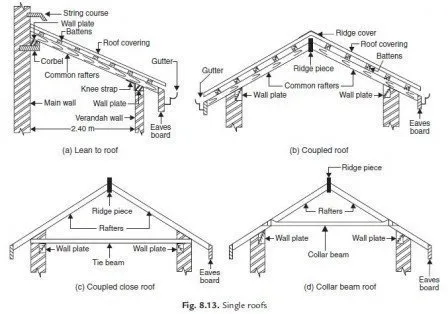Brick masonry is built with bricks bonded together with mortar. For temporary sheds mud mortar may be used but for all permanent buildings lime or cement mortars are used.
The various types of bonds generally used in brick masonry are
1. Stretcher bond
2. Header bond
3. English bond and
4. Flemish bond.
1. Stretcher Bond: A stretcher is the longer face of the brick as seen in the elevation. In the brick of size 190 mm × 90 mm × 90 mm, 190 mm × 90 mm face is the stretcher. In stretcher bond masonry all the bricks are arranged in stretcher courses as shown in Fig. 8.4. However care should be taken to break vertical joints. This type of construction is useful for the construction half brick thick partition wall.
Header Bond
A header is the shorter face of the brick as seen in the elevation. In a standard brick it is 90 mm × 90 mm face. In header bond brick masonry all the bricks are arranged in the header courses as shown in Fig. 8.5. This type of bond is useful for the construction of one brick thick walls.
English Bond
In this alternate courses consist of headers and stretchers. This is considered to be the strongest bond. Hence it is commonly used bond for the walls of all thicknesses. To break continuity of vertical joints a brick is cut lengthwise into two halves and used in the beginning and end of a wall after first header. This is called queen closer. [Ref. Fig. 8.6]. Figure 8.6 shows typical one brick and one and half brick thick wall with English bond.
Flemish Bond
In this type of bond each course comprises of alternate header and stretcher [Fig. 8.7]. Alternate courses start with stretcher and header. To break the vertical joints queen closers are required, if a course starts with header. Every header is centrally supported on the stretcher below it.
Flemish bonds may be further classified as
(a) Double Flemish Bond
(b) Single Flemish Bond.
In case of double flemish bond, both faces of the wall have flemish look, i.e. each course consist of alternate header and stretcher, whereas single flemish bond outer faces of walls have flemish look whereas inner faces have look of English bond [Fig. 8.7 (a), (b)].
Construction of flemish bond needs greater skill. It gives more pleasing appearance. But it is not as strong as English bond. If only pointing is to be used for finished wall, flemish bond may be used to get good aesthetic view. If plastering is going to be used, it is better to use English bond.
Points to be Observed in Supervising Brick Masonry Constructions
The following points should be observed in the construction of brick masonry:
1. Use bricks of good quality with uniform colour, well burnt, with exact shape and size.
2. Before using the bricks in masonry, they should be soaked in water for 2 hours so that bricks do not absorb water from the mortar.
3. Bricks should be laid with the frog pointing upward.
4. Construction of brick wall should start from the end or corner.
5. Brick courses should be perfectly horizontal.
6. Verticality of the wall should be ensured by frequently checking with plumb-bob.
7. Mortar used should be as per specification.
8. Whenever work is stopped brick masonry should be left with toothed end.
9. Use of brick bats should be avoided.
10. Walls should be raised uniformly. In no case difference between adjoining walls be more
than 1 m. In a day no wall should be raised by more than 1.5 m.
11. To get proper key for plastering or pointing, the face joints should be raised to a depth of 12 to 20 mm, when the mortar is green. If plastering or pointing is not to be provided, face joints should be stuck flush and finished neatly.
12. Holdfasts for doors and windows should be embedded in brick masonry with cement mortar or concrete, at the time of constructing the wall itself.
13. Brick masonry should be regularly cured for 2 weeks.
14. For carrying out brick work at higher levels, only single scaffolding should be used.
Advantages and Disadvantages of Brick Masonry Over Stone Masonry
Advantages:
1. Since shape and size of bricks are uniform, it do not need skilled labour for the construction.
2. Bricks are light in weight and hence handling them is easy.
3. Bricks are easily available around cities and their transportation cost is less because their weight is less. Stones are to be brought from quarries which are located only at few places.
4. It is possible to use all types of mortar in brick masonry. For unimportant buildings even mud mortar can be used.
5. Thinner walls can be constructed with bricks but it is not so with stones.
6. It is easy to form openings for doors and windows.
7. Dead load of brick masonry is less.
8. In brick masonry mortar joints are thin and hence construction cost is reduced considerably.
9. Brick masonry has better fire and weather resistance compared to stone masonry.
Disadvantages:
1. Strength of brick masonry is less than that of stone masonry.
2. Durability of brick masonry is less.
3. Brick masonry needs plastering and plastered surface needs colour washing. Stone masonry dont need them and hence maintenance cost is more in brick masonry.
4. Brick masonry absorbs water and there are possibility of dampness. There is no such problem in stone masonry.
5. More architectural effects can be given in stone masonry compared to that in brick masonry.
6. Stone masonry gives massive appearance and hence monumental buildings are built in stone masonry.
Also see:
How to Increase Resistance of Masonry to Water Penetration
Masonry Accessory Materials
Properties of Masonry Assemblages
Specifications of Clay Masonry Units
Mechanical Characteristics of Clay Masonry Units
Clay Masonry Units
Allowable Stresses in Masonry
Masonry-Thickness Requirements
Construction of Masonry
Masonry Cements
Stone Masonry
Types of Bricks









A good brick should absorb 20% water of its own weight.
that’s good knowledge about brick masonry
Hello
We use RCC Frame structure but Brick for wall partition. All walls r 5″ Brick work and size of bricks r 2.75″ X 4.5″ X 9.5″ . Now I have some question
1. At a time maximum what height it should be during masonry work.
2. what will be maximum length ? Do I need to use reinforcement or RCC column after certain interval. Say Can I make 30 feet wall without any intermediate column ?
3. After certain Height do I need to use RCC Bands ?
plze help me and if possible mention reference or calculation
a good civil engineer should have better knowledge of construction materials (specially about bricks).
a good civil engineer should have better knowledge of construction materials (specially about bricks).
I need engineering properties of good mortar…
how to counting the bricks in wall
Am Technology Student i like this